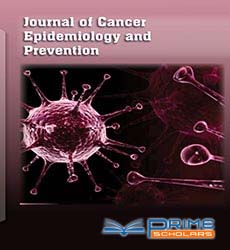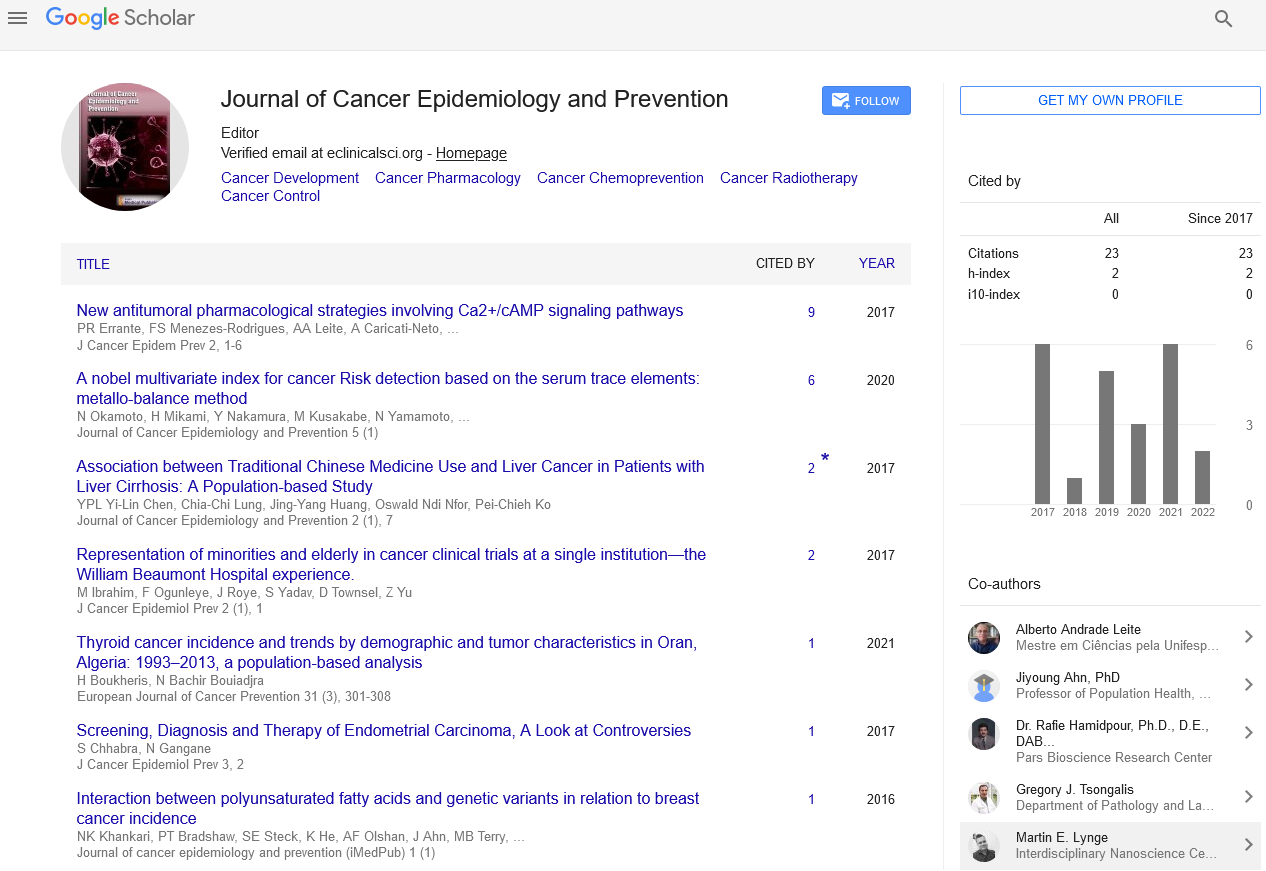Perspective - (2025) Volume 10, Issue 1
cGAS Promote DLBCL Survival through IL6-STAT3 and NF-κB Signaling
Rui Wang*
Department of Hematology, The Second Affiliated Hospital of Soochow University, No. 1055, San Xiang Road, Gu Su District, Su Zhou City, China, Department of Oncology, Suqian Af, China
*Correspondence:
Rui Wang, Department of Hematology, The Second Affiliated Hospital of Soochow University, No. 1055, San Xiang Road, Gu Su District, Su Zhou City, China, Department of Oncology, Suqian Af,
China,
Email:
Received: 28-Jul-2023, Manuscript No. IPJCEP-23-17143;
Editor assigned: 01-Aug-2025, Pre QC No. IPJCEP-23-17143 (PQ);
Reviewed: 15-Aug-2025, QC No. IPJCEP-23-17143;
Revised: 10-Jan-2025, Manuscript No. IPJCEP-23-17143 (R);
Published:
17-Jan-2025, DOI: 10.36648/IPJCEP.25.10.1.36
Abstract
Exogenous and endogenous DNA may trigger the Pathogen-Associated Molecular Pattern (PAMP) during infection and the Danger-Associated Molecular Pattern (DAMP) that senses intracellular DNA, thereby activating the evolutionarily conserved cGAS-STING mechanism for inflammatory reactions. The cGAS-STING signaling cascade plays a crucial role in the pathogenesis and progression of numerous clinical conditions, including neurodegenerative, autoimmune, cardiovascular, and neoplastic conditions. Inhibition of cGAS-STING signaling is effective in treating the first three conditions, but there is controversy regarding whether cGAS-STING should be suppressed or activated in cancer therapy. Deregulation of the cGAS-STING signaling pathway may be the cause and pathogenesis of a variety of pathological conditions; therefore, understanding and modulating cGAS-STING signaling holds tremendous promise for treating a wide range of diseases.
Keywords
cGAS; DLBCL; NF-κB; STAT3; STING
Introduction
Organisms can precisely identify and eliminate harmful microbes in order to survive. Mammal's innate immune system has evolved proficient sensing and defense mechanisms, including the fundamental strategy of distinguishing between exogenous and endogenous DNA, which is the basic component of "life". Essential to this recognition system is the intracellular enzyme cGAS, which bonds to double-stranded DNA (dsDNA) and initiates a tightly regulated signal cascade involving the adaptor STING, thereby triggering a variety of inflammatory responses.
cGAS, also known as MB21D1, belongs to the family of Nucleotidyl Transferase (NTase) enzymes [1]. cGAS was discovered in 2013 for its capacity to bind dsDNA and catalyze the biosynthesis of 2′3′-cGAMP, which then binds and activates STING [2,3]. STING is a 40 kDa dimeric transmembrane protein that resides in the Endoplasmic Reticulum (ER) and functions as a cyclic–dinucleotide sensor [4]. Although cGAS-STING signaling has been extensively investigated to enhance lymphocyte infiltration and tumor elimination, further research is required. Given that cGAS are infrequently inactivated in cancer. It is unknown why malignancies do not contain loss-of-function mutations.
The most common subtype of non-Hodgkin lymphoma, Diffuse Large B-Cell Lymphoma (DLBCL) makes up 30% to 40% of newly diagnosed NHL incidents globally and as much as 80% of NHL death. Malignant lymphomas are biologically depending on the deregulation of cellular pathways that modulate lymphocyte proliferation, division, and apoptosis for their development, maintenance, and progression. In recent decades, it has become exceedingly obvious that aberrant dysregulation of NF-κB and STAT3 activation is a defining feature of several lymphoid malignancies and is directly linked with advanced disease [5]. Despite the discovery that NF-κB contributes to the survival of DLBCL, little is known about its biology or immune-pathological processes.
Description
Cancer can be identified as chromosomal instability, and cumulative genetic instability contributes to the burden of deleterious mutations in numerous genes that fuel tumorigenesis and development to advanced phase [6]. Instability of chromosomes results in the release of nuclear DNA into the cytoplasm in the form of micronuclei; this mislocated DNA is capable of activating the innate immune system [7].
In this study, they compared and investigated the presence and functions of cGAS in clinic samples derived from patients, DLBCL cell lines, and xenograft in vivo tumor models. Tissue microarray analysis revealed that DLBCL patient-derived clinic specimens and cell strains have higher cGAS expression than normal lymph nodes. In DLBCL cell lines, knockdown of cGAS induces cell cycle arrest, reduced proliferation of cells rate by Edu assay, and induced apoptosis. In vivo xenograft tumor models with cGAS silencing exhibited reduced tumor growth. Mechanically, cGAS reduction resulted in the downregulation of IL6-STAT3 and NF-B, which could promote the survival of DLBCL cells.
STAT1 has been widely recognized as a downstream effector of cGAS, contradictory to our expectations, their findings demonstrated that cGAS inhibition also decreased STAT3. Increasing concentrations of recombinant human IL-6 supplementing restored cGAS depletion cells' viability. cGAS deficiency inhibits tumor development in xenograft mouse models. To obtain a more complete understanding of how cGAS may interact with other genes. They analyzed the top genes in TCGA DLBCL cohorts that correlate with cGAS. In DLBCL, cGAS was closely correlated with many genes that promote tumor growth, including MYC, BCL-2, MYD88, STAT3, NFKBB1, and NFKBB2. A pan-cancer analysis reveals that cGAS is overexpressed and predicts a poor prognosis for multiple cancer types.
Challenges with STING Agonists
In cancer immunotherapy, STING activation produces both immune-stimulating and immune-suppressing effects. The discovery of STING in innate and adaptive immune modulation has stimulated and expedited development of human STING agonists as immune-modifying treatments for cancer in clinical trials. However, the preliminary results with STING agonists are unsatisfactory [8].
The observation between cGAS-STING activation and tumor metastasis triggered an evaluation and further investigation of STING agonists in cancer, highlighting the complex relationship between cGAS and STING in this disease. On the one hand, it increased the possibility and rationale for STING inhibitors in late-stage malignancies, and on the other, it prompted researchers to reconsider the adverse effect of STING agonists in cancer. Chromosomally unstable tumor cells contain micronuclei to chronically activate the cGAS–STING pathways and benefit from STING for survival [9], which explains the need for STING inhibitors in advanced human malignancies.
Conclusion
STING antagonists, such as the newly identified covalent STING inhibitors, also demonstrated anticancer properties. Not only STING, but also cGAS has been found to inhibit homologous repair to promote tumorigenesis, indicating the promising application of cGAS inhibitors in cancer therapy. In addition, a recent preclinical study demonstrated that persistent STING activation abolished the function of T celldriven adaptive immunity. Although genomic and behavioral indicators of CIN have been shown to be able to distinguish patients who are more likely to benefit from STING inhibition or stimulation, we believe that additional research and preclinical trials are necessary to explain the application of STING agonists or the antagonists in various tumor types and stages. We are optimistic that additional cGAS inhibitors or antagonists will be discovered and investigated in anti-tumor therapies. Future research on cGAS antagonists in cancer is worth waiting.
Disclosure of potential conflicts of interest
The author declares no competing financial interests.
Funding
This research was supported by funds from Natural Science Foundation of Suqian Science and Technology Bureau (K201903, Z2018076, Z2018213 and Z2022065). Jiangsu Science and Technology Association (JSTJ-2022-004).
References
- Kuchta K, Knizewski L, Wyrwicz LS, Rychlewski L, Ginalski K (2009) Comprehensive classification of nucleotidyltransferase fold proteins: identification of novel families and their representatives in human. Nucleic Acids Res. 37(22):7701-7714.
[Crossref] [Google Scholar] [PubMed]
- Sun L, Wu J, Du F, Chen X, Chen ZJ (2013) Cyclic GMP-AMP synthase is a cytosolic DNA sensor that activates the type I interferon pathway. Science. 339(6121):786-791.
[Crossref] [Google Scholar] [PubMed]
- Wu J, Sun L, Chen X, Du F, Shi H, et al. (2013) Cyclic GMP-AMP is an endogenous second messenger in innate immune signaling by cytosolic DNA. Science. 339(6121):826-830.
[Crossref] [Google Scholar] [PubMed]
- Ishikawa H, Barber GN (2008) STING is an endoplasmic reticulum adaptor that facilitates innate immune signalling. Nature. 455(7213):674-678.
[Google Scholar] [PubMed]
- Sivick KE, Desbien AL, Glickman LH, Reiner GL, Corrales L, et al. (2018) Magnitude of therapeutic STING activation determines CD8+ T cell-mediated anti-tumor immunity. Cell Rep. 25(11):3074-85.
[Crossref] [Google Scholar] [PubMed]
- Bakhoum SF, Ngo B, Laughney AM, Cavallo JA, Murphy CJ, et al. (2018) Chromosomal instability drives metastasis through a cytosolic DNA response. Nature. 553(7689):467-472.
[Crossref] [Google Scholar] [PubMed]
- Lama L, Adura C, Xie W, Tomita D, Kamei T, et al. (2019) Development of human cGAS-specific small-molecule inhibitors for repression of dsDNA-triggered interferon expression. Nat Commun. 10(1):2261.
[Crossref] [Google Scholar] [PubMed]
- Hall J, Brault A, Vincent F, Weng S, Wang H, et al. (2017) Discovery of PF-06928215 as a high affinity inhibitor of cGAS enabled by a novel fluorescence polarization assay. PLoS One. 12(9):e0184843.
[Crossref] [Google Scholar] [PubMed]
- Vincent J, Adura C, Gao P, Luz A, Lama L, et al. (2017) Small molecule inhibition of cGAS reduces interferon expression in primary macrophages from autoimmune mice. Nat Commun. 8(1):750.
[Crossref] [Google Scholar] [PubMed]
Citation: Wang R (2025) cGAS Promote DLBCL Survival through IL6-STAT3 and NF-?B Signaling. J Cancer Epidemiol Prev. 10:36.
Copyright: © 2025 Wang R. This is an open-access article distributed under the terms of the Creative Commons
Attribution License, which permits unrestricted use, distribution, and reproduction in any medium, provided the original author
and source are credited.

